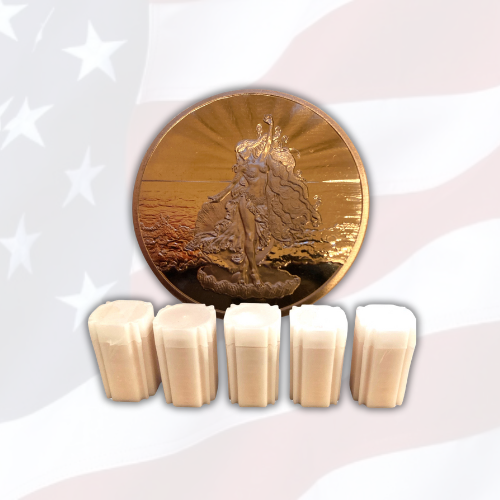Published 08/17/2023
The history of using copper as money is absolutely fascinating! Copper has been a valuable metal for centuries due to its beauty, durability, and malleability. In fact, ancient civilizations recognized these qualities and began using copper as a form of currency.
One of the earliest examples dates back to ancient Mesopotamia around 3000 BCE when the Sumerians created their own system of weights and measures using copper pieces. These small circular discs were stamped with symbols representing various goods or commodities they could exchange for.
The Sumerians took a giant leap forward by devising a system to trade goods and services using copper as currency. Imagine that! Copper, being readily available, was easily shaped into small, standardized pieces called rounds. These rounds would vary in size and weight depending on their value.
This remarkable development revolutionized the Sumerian society. No longer were they bound by the limitations of barter trade; copper allowed them to exchange various commodities with unparalleled ease. It quickly became the lifeblood of their economy, with individuals using it to buy food, clothing, land, yes – even slaves!
These enterprising folks didn't stop there. They took their innovative thinking up a notch by creating seals with specific designs. These seals represented different values and ensured secure transactions while preventing counterfeiting (talk about being ahead of their time!). Merchants would use these seals to authenticate each transaction and ensure fairness.
Can you imagine how exciting it must have been for those who witnessed the birth of this monetary system? The possibilities seemed endless as these clever minds continued to explore new ways to enhance their economic prowess throughout Sumerian city-states like Ur and Uruk.
Jumping ahead several centuries to Ancient Egypt, copper continued to hold great importance as a form of currency. Egyptians used intricate copper bars and rings as units of trade. The rulers even started issuing standardized copper coins with engraved symbols that represented their power and authority.
As trade expanded beyond Egypt's borders, these copper rings became highly sought-after items across neighboring regions such as Mesopotamia and the Levant. Due to their scarcity in those areas, they eventually gained immense value and became an early form of international currency.
The usage of copper as a medium of exchange lasted for several centuries until other metals like gold and silver gained prominence. However, even during this transition period, copper still played a significant role in smaller transactions where gold or silver was less practical due to higher value or scarcity.
In addition to being used as money, copper held cultural significance for the Egyptians. It was associated with Hathor, the goddess of beauty and love. Temples dedicated to her often-contained large quantities of this metal which also reflected their wealth and prosperity.
This innovative use of copper by Ancient Egyptians showcases their inventiveness in establishing advanced economic systems long before modern money existed. Their recognition of the intrinsic value and versatility of copper was not only economically groundbreaking but also culturally symbolic – solidifying the metal's importance throughout ancient Egyptian history.
Moving on to ancient China during the Zhou Dynasty (1046–256 BCE), this period marked an advancement in early forms of money. Copper coins were introduced and had holes in the middle, allowing them to be conveniently carried on strings or cords. Copper coins were widely used across different regions and were minted by both the central government and local authorities. The production process involved casting molten copper into molds, resulting in round coins with square holes at the center. These copper coins were referred to as ban liang during this period.
One remarkable feature of these coins was their consistent weight and shape, which contributed to their widespread acceptance among merchants and traders not only within China but also in neighboring countries. They facilitated economic growth by making transactions more reliable and efficient.
In addition to its function as a medium of exchange, copper had significant symbolic importance within Chinese culture. It represented wealth, good fortune, and prosperity. Copper coins were often seen as protective talismans, contributing to the popular belief that they brought luck and repelled evil spirits.
The wide circulation of copper coins also helped stabilize society by establishing a standard value system. Due to the uniformity in weight and quality among these coins, it became easier for individuals from all walks of life to ascertain the worth of goods or services being exchanged.
The use of copper as money shaped China's economic landscape during this era. Its broad acceptance fostered increased commercial activity, leading to prosperous markets and flourishing cities throughout ancient China.
Overall, the adoption of copper coins revolutionized trade dynamics in ancient China during the Zhou Dynasty by providing stability, promoting economic growth, and becoming an essential aspect of everyday life for its citizens.
Fast forward again to medieval Europe. Copper once again played a prominent role in shaping monetary systems. Various local governments minted their own copper coins to facilitate trade between regions.
During the Industrial Revolution in the 18th century, advancements in mining technology made it possible to produce large quantities of high-quality copper at affordable prices. This led many countries such as the United States and England to adopt copper cent coins as a standard unit of currency.
Today, although we no longer use copper as a primary form of currency, it remains highly valued for its industrial applications and aesthetic appeal. Nonetheless, we can't help but marvel at how this incredibly versatile metal has deeply influenced human history through its journey from being used for everyday exchanges to becoming tangible proof of wealth and prosperity throughout countless civilizations!


